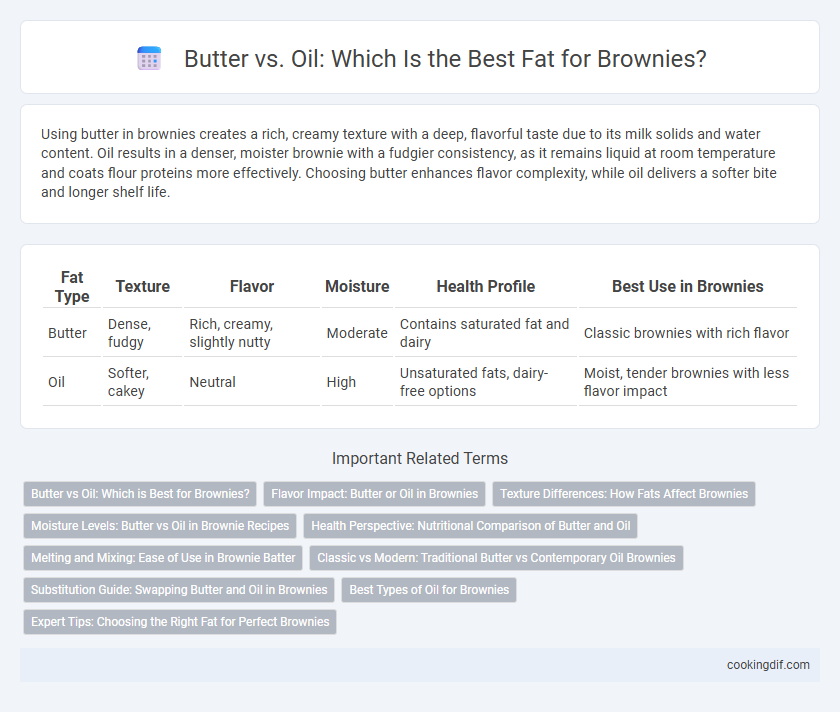Using butter in brownies creates a rich, creamy texture with a deep, flavorful taste due to its milk solids and water content. Oil results in a denser, moister brownie with a fudgier consistency, as it remains liquid at room temperature and coats flour proteins more effectively. Choosing butter enhances flavor complexity, while oil delivers a softer bite and longer shelf life.
Table of Comparison
| Fat Type | Texture | Flavor | Moisture | Health Profile | Best Use in Brownies |
|---|---|---|---|---|---|
| Butter | Dense, fudgy | Rich, creamy, slightly nutty | Moderate | Contains saturated fat and dairy | Classic brownies with rich flavor |
| Oil | Softer, cakey | Neutral | High | Unsaturated fats, dairy-free options | Moist, tender brownies with less flavor impact |
Butter vs Oil: Which is Best for Brownies?
Butter provides a rich, creamy flavor and creates a denser, fudgier brownie texture due to its water content and milk solids. Oil, being 100% fat, results in moister, chewier brownies with a softer crumb, as it coats flour proteins differently than butter does. Choosing butter enhances flavor complexity, while oil offers superior moisture retention and a smoother mouthfeel; the best option depends on desired brownie texture and flavor profile.
Flavor Impact: Butter or Oil in Brownies
Butter enhances brownie flavor by adding rich, creamy, and slightly nutty notes due to its milk solids and natural caramelization during baking. Oil provides a more neutral taste, allowing other ingredients like cocoa and sugar to shine without fatty flavor interference. Choosing butter over oil intensifies the overall flavor complexity, creating a deeper, more indulgent brownie experience.
Texture Differences: How Fats Affect Brownies
Butter in brownies creates a rich, tender crumb with a slightly crisp edge due to its water content and milk solids, which promote browning and a chewy texture. Oil produces a denser, moister brownie with a smoother texture because it remains liquid at room temperature, preventing the formation of a firmer structure. Choosing butter enhances flavor complexity and flakiness, while oil ensures consistently soft and fudgy brownies ideal for a gooey bite.
Moisture Levels: Butter vs Oil in Brownie Recipes
Butter enhances brownies with a rich, creamy texture due to its milk solids and water content, contributing to slightly denser, fudgier results. Oil, being 100% fat, increases moisture retention, producing softer, more tender brownies with a consistently moist crumb. Choosing between butter and oil directly impacts brownie moisture levels and texture, with butter offering richer flavor and oil delivering superior moistness.
Health Perspective: Nutritional Comparison of Butter and Oil
Butter contains saturated fats and cholesterol, which can raise LDL cholesterol levels and potentially impact heart health negatively, while oil--especially unsaturated oils like olive or canola--provides healthier fats that support cardiovascular function. From a nutritional standpoint, oils offer more essential fatty acids and vitamin E, contributing to antioxidant benefits absent in butter. Choosing oil over butter in brownies can reduce saturated fat intake and improve the overall lipid profile, making the treat a healthier option.
Melting and Mixing: Ease of Use in Brownie Batter
Butter melts gradually, creating a smooth and creamy texture that blends easily into brownie batter, enhancing flavor and richness. Oil, with its liquid state at room temperature, mixes effortlessly and uniformly, ensuring a consistent batter without the need for melting. The choice between butter and oil affects the ease of mixing and final texture, as butter requires melting or softening, while oil offers immediate fluidity for seamless incorporation.
Classic vs Modern: Traditional Butter vs Contemporary Oil Brownies
Classic brownies rely on butter to provide a rich, creamy texture and deep, caramelized flavor through the Maillard reaction during baking. Modern oil-based brownies offer a lighter, moister crumb and enhanced shelf life due to oil's liquid state at room temperature. Choosing butter delivers a traditional, dense bite with complex taste, whereas oil yields a softer, more tender brownie favored in contemporary recipes.
Substitution Guide: Swapping Butter and Oil in Brownies
Butter and oil both provide essential fat in brownie recipes, but swapping them affects texture and flavor; butter offers a rich, creamy taste and firmer structure due to its water content, while oil results in moister, denser brownies with a more neutral flavor. When substituting, use a 1:1 ratio by volume, but reduce oil slightly if replacing butter to avoid excessive greasiness, or add a small amount of water to mimic butter's moisture. Understanding the fat content and moisture balance helps achieve desired consistency and taste in homemade brownies.
Best Types of Oil for Brownies
When choosing the best types of oil for brownies, vegetable oil, canola oil, and light olive oil are preferred for their neutral flavor and moist texture contribution. Coconut oil adds a subtle sweetness and richness, enhancing the fudgy consistency without overpowering the chocolate taste. Using oils with a mild profile ensures brownies remain tender and flavorful while maintaining a desirable crumb structure.
Expert Tips: Choosing the Right Fat for Perfect Brownies
Butter delivers rich flavor and tender crumb in brownies due to its milk solids and water content, enhancing texture and taste uniquely compared to oil. Oil creates denser, moister brownies by coating flour proteins more thoroughly, which helps retain moisture and provides a fudgier bite favored in some recipes. Experts recommend using butter for traditional, flavorful brownies and oil when aiming for extra moistness or vegan alternatives, balancing texture preferences with dietary needs.
Butter vs Oil for brownie fat Infographic

 cookingdif.com
cookingdif.com